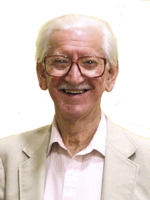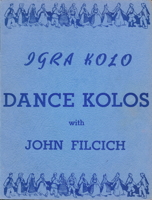
|
Folk Dance Federation of California, South, Inc.
|

|
CLICK AN IMAGE TO ENLARGE
In all forms of dancing, there are accepted customs, manners and courtesies; in addition to all of these the kolos have a lot of traditions. Moreover, community feeling and spirit runs high. The men dance to show their masculine traits and fancy steps, and the women who are single often dance to attract them; the elders often look on to insure proper mingling of the sexes. These factors then determine the style and in order to preserve it we must sometimes take artificial measures. Generally speaking, only the men can take large, heavy steps, stamp the floor hard, and perform other near-gymnastic feats. The women dance almost in place with very small steps and with a bounce, restrained, and sedate; they never even try to outdo the men, but serve to add color, lightness, inspiration, and if we may say, beauty to the dance.
The role of the leader is well defined and varies from region to region. In most of the dances, as described in my book "Igra Kolo: Dance Kolos with John Filcich," he is the one who by himself or with others starts the kolo, describes the steps with a few walking steps, accelerates and improvises on the steps, and in general leads the kolo around. His fancy steps and movements are not interpreted as showing off, because that adds life to the dance and is a credit to the kolo as a whole. He may also institute rest periods where all walk through the dance; he is expected to last the entire dance (native musicians play a kolo ten or fifteen minutes), though other dancers may leave or join at will. Tradition prescribes that only the men can be leaders.
In all cases there should be one circle on the floor, with one leader. Multiple circles or private groups do not convey the proper community spirit and are not in conformance with traditional style. The line forms to the leader's left; only those unfamiliar with kolos would dare take his right hand.
Kolos are among the liveliest and most enjoyable dances in the world. They are very practical dances and can be adopted by all recreational international folk dance groups; most of them do not require partners, but reflect a very high community spirit. There are easy ones and there are hard ones. Then there is that ever present urge to reach higher degrees of executing the steps and learning new improvisations that makes one enjoy them so much and never seem to get enough of them.
Most of the steps used in kolos are described in the book with the dances in which they are used. However, at least three need special attention and practice and they are described below by themselves. These steps sometimes are a complete kolo in themselves. However, they do not have names in the native language, therefore we have to use suggestive names to designate the steps. These steps must be seen to be appreciated.
KOLO PAS-DE-BASQUE or Kokonješte step resembles more the Slavic polka step than the pas-de-basque of other lands. It is hoppy, usually done in place or danced backwards as in Kokonješte kolos.
count "and" – Lift, or hop lightly on left foot for impetus.
count "one" – Step, or leap onto right foot in place.
count "and" – Step on left foot next to, or in front of, right foot. IMPORTANT: Left foot does NOT cross right foot.
count "two" – Step on right foot in place.
The above is a step to the right; repeat; reversing footwork to do it to the left. It is usually done in a series of three times (R,L,R L,R,L R,L,R then reverse) preceded by two low leaps in the same direction. PRACTICE: Any Kokonješte kolo.
HEEL-TOE STEP or Hop-Step-Step, the so-called "Lame Duck" step, which ends Seljančica kolo, really should have no "heel-toe" work, but:
count "one" – Lift, or hop on left foot (barely raising it off the floor), at the same time BASIC-KOLO STEP is probably the most common and picturesque of all footwork. It involved from a simple "step, close, step, close," but now done as follows:
Measure 1
From: Igra Kolo: Dance Kolos with John Filcich.
placing right foot forward on the floor. This becomes "lift left, tap right."
count "and" – Step on right foot in line of direction (tap right).
count "two" – Step on left foot in line of direction; this is a heavier and bigger step,
stepping beyond right foot.
count "and" – Pause.
The above is the step to the right; it is usually done in a series of four or eight times, then repeated in the opposite direction. The last step of a series is a change step: two hops on both feet. To learn, use Djevojačko kolo for a starter, though the actual dance does not call for that step. To accelerate, use Milica kolo.
count "one" – Hop (or lift) on left foot (barely raising it off the floor), at the same time
placing right foot on the floor.
count "and" – Step on right foot. This is a second tap, and a quiver or bounce
should be felt.
count "two" – Quickly step on the left foot behind the right foot.
count "and" – Pause.
Measure 2
count "one" – Bring right foot next to left foot, using a small leap to the
right (this will seem like a hop).
count "two" – Hop on right foot in place, left foot free.
Measure 3-4 – Repeat measures 1-2 to the left, reversing footwork.
A double hop is felt at the end of the step; you will note that the "basic-kolo step" is identical to the "heel-toe step," except that the hops at the end give it a second measure. Also, in the "basic-kolo step" the left foot is thrust in back instead of forward. IMPORTANT: The step should be done as much up and down as it is sideways, in other words, it should be done in place. Improvisations add to the step. PRACTICE: Malo Kolo.
Slav-Art Music Co., Oakland, CA.: 1953.
Used with permission of the author.
